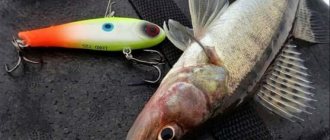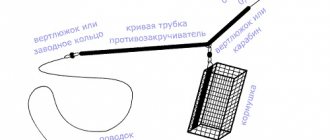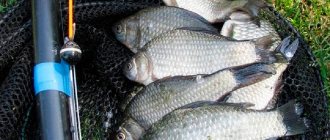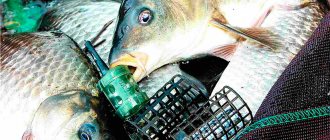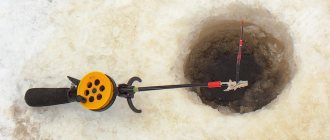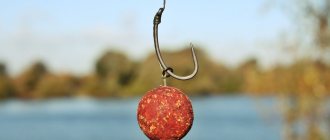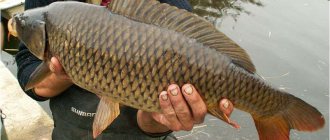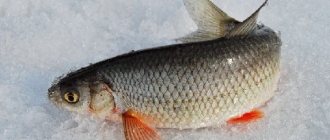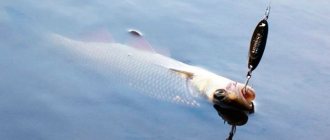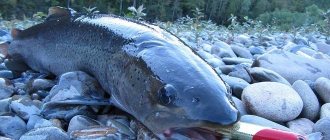Peculiarities of behavior of crucian carp in spring
The temperature regime at the end of winter and beginning of spring significantly affects the possible bite. The warmer the air and, accordingly, the water, the greater the likelihood of returning from fishing with a catch. In cold water, after the ice has melted, the fish are lethargic and difficult to tempt with any bait.
The normal temperature for resuming the bite of crucian carp is considered to be +6…+10°C. In such water, the fish are quite active and take the bait, although carefully, but deeply. After winter, the pre-spawning feast begins, so the possibility of good fishing increases. By mid-May, spawning begins and fishing will have to stop.
Find out how to catch crucian carp in June using a float rod.
Distinctive features when catching crucian carp in the spring with a float
Unlike the hot summer, fishing for crucian carp in the spring with a float rod has a number of very important features that any angler must take into account at this time of year:
- Shallow fishing depth - unlike in summer, when crucian carp tries to hide from the heat in deeper places with cool water, in spring it spends most of the day on the coastal shallows, where the water is well warmed up and there is plenty of food.
- Using thin, inconspicuous equipment - spring crucian carp is not as lively as in summer, so to catch it you need a fairly thin and sensitive equipment.
- Caution and silence - in the spring the water is still very clear, and therefore, while fishing, the fisherman needs to stand up to his full height as little as possible and move along the shore near the gear so as not to spook the fish.
- Use of baits - trying to accumulate a sufficient supply of nutrients for spawning in the spring, fish prefer more nutritious baits.
- Fishing during the day - unlike in summer, in spring this fish is caught from 7-8 o'clock in the morning until the evening.
Where is the best place to fish?
The first spring fishing is carried out in shallow waters, where the water warms up much faster. Here the activity of small invertebrates begins and underwater vegetation comes to life. All this attracts crucian carp, which, in addition to food, is looking for an opportunity to warm up here.
Shallow places in ponds and rivers, well lit by the sun, are a favorite place for crucian carp in the spring. In them, the fish gain weight and are not too careful when biting - they can greedily grab the bait, sharply pulling the float under the water. The fishing depth is from 0.5 to 1.5 m; in such places, crucian carp gather in schools and delight with the intensity of the bite.
Important! In clear spring water, crucian carp sees everything that happens on the shore. Fishermen must remain quiet, not make sudden movements and wear protective clothing.
Technique for catching crucian carp with a float rod in spring
After you have collected the optimal gear for this time of year, you can begin to master fishing techniques and consider the features of spring fishing for crucian carp from the shore and from a boat.
The main technical techniques when fishing with a float rod are casting, feeding, hooking, and retrieving:
- Feeding - when catching crucian carp on a float in the spring, bait is as important as bait. Feed the selected promising location in early spring with a mixture of soil from molehills or dense coastal soil with crushed worms and small food bloodworms. At the end of spring, most of the bait consists of heavy porridges - millet, pearl barley, to which breadcrumbs, cake and a small amount of bait are added. They feed by making balls out of the mixture and throwing them with their hand at the intended fishing point. At least 15-20 minutes should pass between feeding and casting the baited equipment - during this time, the fish, disturbed by the fall of heavy balls into the water and attracted by the bait, will gather at the intended point.
- Casting – casting the equipment should be done in a smooth pendulum manner. When entering the planned fishing spot, the equipment should create as little noise as possible.
- Hooking – crucian carp bites in the spring are more confident and noticeable. The float may, after several smooth movements up and down, begin to move sharply to the side, emerging and lying flat on the water. Often the bite of crucian carp is very similar to that of perch - the float suddenly goes under the water without warning movements. For all the movements of the float described above, a sharp and short hook should be performed.
- Fishing – you should catch the crucian carp quickly, but carefully. The main thing in the fishing process is to prevent the fish from tangling the fishing line with snags, grass, or flooded bushes. Large and medium-sized crucian carp are removed from the water using a landing net.
Float rod equipment
For any fishing, it is important to choose the right equipment, as this is the key to a good bite and a high-quality catch. Spring crucian carp can be both capricious and greedy, so it is important not to frighten it off with overly powerful tackle, but also to prevent the fishing line from slipping or breaking.
Attention is paid to the following parts of the gear:
- rod;
- coil;
- fishing line;
- float;
- sinkers;
- leash with hook.
Rod
For close casts (up to 10 m), a lightweight carbon fiber fly rod with a length of about 4.5 m is used. It is sensitive, light and well suited for fishing at a depth of 1–1.5 m. For long casts, it is worth using a Bolognese fishing rod with a length of 5–7 m With a casting range of more than 10 m and a fishing depth of 1.5 m, this rod is most effective .
Find out also how to choose the right gear for catching pink salmon.
Coil
A small bobbin or spinning reel is quite suitable for spring crucian fishing. The second is preferable, since many meters of fishing line can be wound on it in advance, which makes it easier to repair the gear after snags and subsequent breaks.
A bobbin reel is more practical in explored areas where no unpleasant surprises are expected. It can be very small so as not to increase the weight of the fishing rod and not spoil its sensitivity.
fishing line
For spring fishing for crucian carp, monofilament with a thickness of 0.16–0.18 mm is used as the main fishing line. It is inexpensive and practical, and fish will not damage it when played.
Float
Fishing in the spring requires light tackle with minimal load. The float for such fishing is chosen to be elongated and thin. You can fish with a classic goose feather or its plastic imitation.
Important! When fishing at shallow depths, you need to choose inconspicuous floats with a neutral and discreet color. This way they won't confuse or scare the fish.
Sinkers
Each fisherman, based on his experience, has formed his own characteristics of the location of the weights on the fishing line. In this case, lead pellets weighing about 0.3 g are used. Two such sinkers are attached at a height of 20 cm from the leash, and one is placed near the leash attachment loop. Depending on the characteristics of the reservoir, you can place a small pellet weighing 0.1 g in the middle of the leash line.
Leash with hook
A leash with a diameter of 0.12–0.14 mm and a length of about 30 cm is placed on a loop of the main thread. When fishing with dung, earthworms or maggots, hooks No. 8–10 are knitted, but if it is intended to be used as a bloodworm attachment, then the hooks should be No. 12–14.
Familiarize yourself with the features of catching grass carp in summer.
Tackle for catching crucian carp in April
Having decided on the place of possible (successful) fishing, it is necessary to resolve the issue of choosing gear. It is preferable to choose a light fishing rod for crucian carp, as for roach and other topwater fish.
The ideal tackle looks like this: the thickness of the main line is no more than 0.12 mm; float -0.4-0.5 g; leash - 0.10 mm; thin long hook of red color, size 12-14.
Read! Bait for catching crucian carp
When preparing the tackle, the following point must be taken into account: the last sinker should be in close proximity to the bottom, followed by a leash 10 centimeters long.
All attempts to hook a crucian carp on a heavy, large rod will invariably lead to a break in the leash, which will make enough noise and scare away possible prey from the fishing spot for a long time. Of course, in this case, fishing in the chosen place is over, even if the fish was well fed.
Baits and lures
In cold water, crucian carp prefers “meat” baits with a high protein content. The best choice is dung worms , which have an attractive smell and color for fish, and also remain active for a long time when hooked. Maggots and bloodworms also “behave” well on the hook, moving and attracting fish. But they have a drawback - given their size, they often tempt other fish to bite.
Instead of crucian carp, you can use such a bait to catch small perch, bleak, perch, or even a bull the size of a little finger. Vegetable baits are not very attractive to underwater inhabitants in the spring months. Unless, with the use of modern flavorings, you can force the fish to taste dough, semolina, or a ball of bread. By mid-May, crucian carp may bite on a grain of pearl barley porridge, a grain of peas or corn.
If the bite is weak, you can try to diversify the diet and offer the fish a “sandwich”:
- bloodworms with corn grain;
- pearl worm;
- maggot with canned peas.
Did you know? When a reservoir dries out, crucian carp burrow deep into the silt and thus survive the drought. A fleshy, dense body, powerful scales and a subcutaneous layer of fat allow it to survive until water appears.
Where and when to catch crucian carp - searching for crucian carp sites
As a rule, crucian carp loves quiet and peaceful places with a muddy bottom and an abundance of vegetation. It does not always bite in clear water; in such cases, crucian carp are caught at the very edge of the reeds or in windows between vegetation. You can get into the water and pull out the vegetation with your hands to make a “window” for fishing in the reeds yourself. True, after this the crucian carp will not return immediately; you need to feed it and catch it the next morning.
The best period for catching this fish is three summer months and one week before spawning after the crucian carp has left winter hibernation. Folk signs of the beginning of an intense bite: rose hips are blooming, algae are growing, reed shoots are appearing. For approximate biting activity by month, see the Crucian Carp Biting Calendar.
The timing of the start and end of the bite in different bodies of water may differ and also depends on the weather. Usually the morning bite of crucian carp begins at 5 am and lasts until 10 pm, sometimes lasting until lunch. In the evening, crucian carp bite from 17–18 hours until sunset. In cloudy weather, crucian carp can bite throughout the day. During periods of prolonged summer heat, crucian carp bite in the early morning, late evening and at night.
Choice of bait
You need to feed with approximately the same food that you plan to use for bait. For example, bloodworms and worms are finely chopped and mixed with coastal soil. A good result is obtained by using earth from mounds dug by moles in baiting.
From mid-spring, pearl barley and millet porridge are used, to which semolina, breadcrumbs, sunflower cake and a little basic bait are added. Dense balls rolled from complementary food are thrown into the future fishing area 20 minutes before it starts.
Baits
Fishing for crucian carp in April is unpredictable and this should be taken into account when choosing bait; the fisherman’s assortment should, if possible, include the entire range of expected baits. Since fish require high-calorie food in April, fishing should begin with baits of animal origin; only if the result is negative should one begin to experiment with plant baits.
Basically, a good result is observed if you catch it with a worm or bloodworm, and the mahogany also behaves well. But in order for the results of your fishing to improve significantly, you need to feed the fish. April is the month when bait can be almost anything - pearl barley, makha, ready-made mixtures, breadcrumbs, etc.
The main thing is not to overdo it with the quantity. If possible, it is better to start feeding in the evening; if this is not possible, then you can feed immediately upon arrival at the place; the bait will make itself felt in about twenty minutes, by which time you will have already prepared the gear and equipped your fishing spot.
To be honest, fishing for crucian carp in April is not as exciting as in the summer months; the bites are cautious and barely noticeable. The crucian carp moves the bait from side to side with light pokes and only after a couple of minutes of such play does a bite follow, it is at this moment that the hook should follow. Despite such mockery, this time cannot be missed. The reward of a persistent and prepared fisherman can be crucian carp weighing up to one kilo, which is not so bad.
